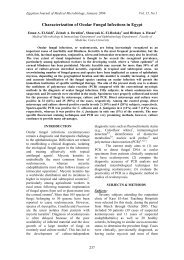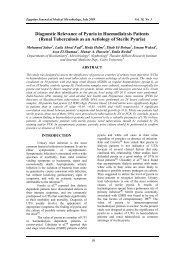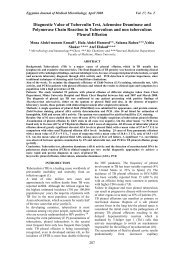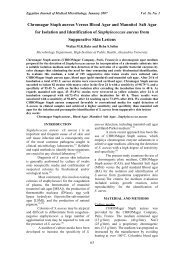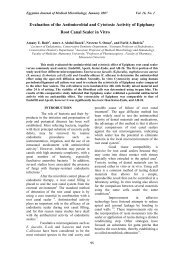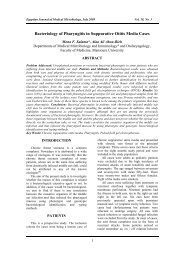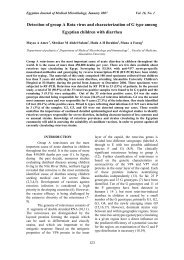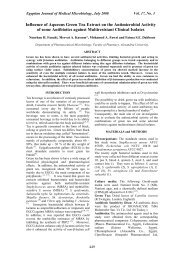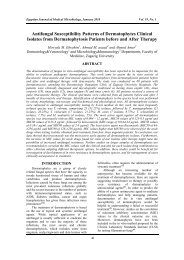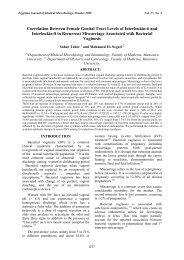Strain differentiation of Mycobacterium tuberculosis complex ...
Strain differentiation of Mycobacterium tuberculosis complex ...
Strain differentiation of Mycobacterium tuberculosis complex ...
You also want an ePaper? Increase the reach of your titles
YUMPU automatically turns print PDFs into web optimized ePapers that Google loves.
Egyptian Journal <strong>of</strong> Medical Microbiology, January 2008 Vol. 17, No. 1<br />
pyrazinamide (PZA). The following critical<br />
concentrations were used: RIF(1.0 ug/ml),<br />
INH(0.2, 1.0 and 5.0 ug/ml), STR(2.0 and 10.0<br />
ug/ml), EMB(5.0 ug/ml), PZA(25.0 ug/ml).<br />
Molecular identification <strong>of</strong> MTB isolates: DNA<br />
<strong>of</strong> suspected MTB isolates was extracted by the<br />
mini-glass bead agitation procedure as previously<br />
described (15). PCR amplification <strong>of</strong> IS6110<br />
(MTB <strong>complex</strong>-specific) and IS1245 (M.aviumspecific)<br />
(14) was performed in a multiplex PCR<br />
assay.<br />
Multiplex PCR assay was performed on the<br />
purified DNA as follows: In a final volume <strong>of</strong> 25<br />
ul; 1 ul <strong>of</strong> DNA template, 0.6 ul (5 uM) <strong>of</strong> each <strong>of</strong><br />
the four primers and 12.5 ul HotStar Taq Master<br />
Mix (Taq DNA polymerase, 10x Taq buffer, 3<br />
mM MgCl 2 , and 400 uM dNTPs; Quiagen, CA,<br />
USA) were added to 9.1 uL distilled water. The<br />
primers used to amplify 123 bp fragment <strong>of</strong><br />
IS6110 were: KDE1 (5` -CCT GCG AGC GTA<br />
GGC GTC GG) and KDE2 (5` -CTC GTC CAG<br />
CGC CGC TTC GG). The primers used to amplify<br />
a 378 bp fragment <strong>of</strong> IS1245 were: MA1 (5` -CTT<br />
GCT GGA GGT GCT CGA CG) and primer MA2<br />
(5` -GGA GGT GCC GTG CAG GTA GG).<br />
MTB strain H37Rv and M. avium ATCC 871031<br />
were used as PCR controls. Thermocycling was<br />
done in Gene-Amp PCR system 9700<br />
Thermocycler (Perkin-Elmer Inc., CA). PCR<br />
conditions were as follows: initial denaturation at<br />
96 o C for 15 min, then 35 cycles composed <strong>of</strong><br />
denaturation at 96 o C for 30 sec, annealing at 64<br />
o C for 30 sec, and extension at 72 o C for 30 sec.<br />
Final extension at 72 o C for 7 min was done at the<br />
end <strong>of</strong> cycles. PCR amplicons were<br />
electrophoresed through 2% agarose gel<br />
supplemented with 50 ug ethidium bromide, at<br />
100 V for 1 hr. DNA bands were visualized by<br />
UV transilluminator, and compared to control<br />
strains.<br />
PCR RFLP analysis <strong>of</strong> OxyR gene: Isolates<br />
were further characterized Using PCR RFLP<br />
analysis <strong>of</strong> OxyR gene to differentiate between M.<br />
bovis & M. <strong>tuberculosis</strong> within the MTB <strong>complex</strong>.<br />
A 548 bp segment <strong>of</strong> the OxyR gene was<br />
amplified as described previously (16 ) using the<br />
following oligonucleotide primers: forward<br />
primer, 5 ’GGT GAT ATA TCA CAC CATA-3 ’ ;<br />
reverse primer , 5 ’ – CTA TGC GAT CAG GCG<br />
TAC TTG-3’. The following cyclic conditions<br />
were used for amplification <strong>of</strong> the OxyR gene:<br />
denaturation at 96 o C for 5 min, 35 cycles <strong>of</strong> 30<br />
sec at 96 o C, 30 sec at 57 o C, 45 sec at 72 o C and<br />
finally extension for 6 min at 72 o C. DNA gel<br />
Electrophoresis was done to test the amplification<br />
using 2% agarose gel under 100 V for 1 hour. the<br />
PCR product (10 ul) was digested with 4 U <strong>of</strong> AluI<br />
( New England Biolabs, Beverly, Mass., USA),<br />
the reaction mix included 12 ul water, 2.5 ul<br />
enzyme buffer, and 10 ul PCR product. 100 bp<br />
marker was used as a ladder. 4-20% Novex precast<br />
acrylamide gel was used for doing the gel<br />
electrophoresis for 3 hours, at 100V, using TBE<br />
buffer cooled to 6 o C.<br />
<strong>Strain</strong> typing (IS6110 RFLP)<br />
Isolates <strong>of</strong> MTB were typed by the<br />
standard IS6110-RFLP method as described by<br />
van Embden et al (5). In brief, a 2-3 week old<br />
subculture isolates in 7H9 broth was incubated<br />
overnight with cycloserine (1 mg/ml) at 37 o C. The<br />
sedimented cells were harvested to 1.5 ml<br />
microcentrifuge tube and incubated for 20 min at<br />
80 o C. Chromosomal DNA was isolated by<br />
disruption <strong>of</strong> cells with siliconized glass beads as<br />
described previously (14). About 0.75 to 1.25 ug<br />
<strong>of</strong> genomic DNA was digested for 2 h with 10 U<br />
<strong>of</strong> pvuII (BRL Life technologies Inc., Gaitherburg,<br />
MD) and electrophoresed on 1.0% agarose gel<br />
electrophoresis overnight. The restriction<br />
fragments were transferred by vacuum blotting to<br />
a Hybond-N+ nylon membrane (Amersham Corp.,<br />
Arlington heights, IL). Hybridization was carried<br />
out under stringent conditions with 247-bp IS6110<br />
PCR fragment, using the Amersham ECL direct<br />
labeling and detection kit. Banding patterns on<br />
resulting autoradiographs were scanned and<br />
analyzed using molecular analysis s<strong>of</strong>tware (Bio<br />
Image, Ann Arbor, MI) (14).<br />
Spoligotyping<br />
Spoligotyping was performed as previously<br />
described by Kamerbeek et al., (17). The direct<br />
repeat (DR) region was amplified by PCR using<br />
primers derived from the DR sequence. The<br />
primers used were DRa<br />
(GGTTTTGGGTCTGACGAC) and DRb<br />
(CCGAGAGGGGACGGAAAC). Fifty<br />
microliters <strong>of</strong> the following reaction mixture were<br />
used for the PCR: 10 ng <strong>of</strong> DNA, 20 pmol each <strong>of</strong><br />
primers DRa and DRb, each deoxynucleoside<br />
triphosphate at 200 mM, PCR buffer, and 0.5 U <strong>of</strong><br />
taq polymerase. The mixture was heated for 3 min<br />
at 96C and subjected to 20 cycles <strong>of</strong> 1 min at 96C,<br />
1 min at 55C, and 30 s at 72C. The amplified<br />
DNA was hybridized to a set <strong>of</strong> 43 immobilized<br />
oligonucleotides, each corresponding to one <strong>of</strong> the<br />
unique spacer DNA sequences within the D R<br />
locus. The sequences <strong>of</strong> the oligonucleotides used<br />
are given in table 1. These oligonucleotides were<br />
covalently bound to a Hybridization membrane.<br />
The membrane (Biodyne C) was obtained from<br />
Pall Biosupport, Portsmouth, UK, and was<br />
activated as previously described (17). For<br />
hybridization, 20 ul <strong>of</strong> the amplified PCR product<br />
was diluted in 150ul <strong>of</strong> 2X SSPE supplemented<br />
with 0.1% sodium dodecyl sulfate and heat<br />
denatured. The diluted samples (130ul) were<br />
pipetted into the parallel channels in such a way<br />
that the channels <strong>of</strong> the miniblotter apparatus were<br />
perpendicular to the rows <strong>of</strong> oligonucleotides<br />
deposited previously. Hybridization was done for<br />
60 min at 60C. After hybridization, the membrane<br />
was washed as previously described (17).<br />
144



